How to Make Money with Chatbots?

Key takeaways
- Did you know that 74% of customers now prefer chatbots to communication with corporate agents? Learn more about chatbot trends and statistics to create an up-to-date product.
- Understanding which monetization strategy to choose for your chatbot can be rather challenging. Find out in our article which experts can help you select the one that will meet your business needs precisely.
- Discover the most popular monetization strategies, from the partnership approach to the subscription-based model. Explore the nuances, pros, and cons of each strategy to find the most relevant for your product.
- Check out real-world examples of successful commercial usage of chatbots for inspiration to create your own profitable product.
In the digital age, chatbots have become more than just a tool to automate communication with your customers. They have become an insight-gathering instrument, a tool that provides more personalized CX, and a revenue stream that countless companies use to increase their profits.
For example, 23% of companies are currently using AI chatbots, and the number of organizations that integrate this technology to streamline their operations keeps steadily growing. If you’ve been wondering how to turn chatbots into a profitable venture, you’ve come to the right place. Keep reading this article, and you will find out the methods of chatbot monetization and ways to make money with AI that can take your business to the next level.
Major trends in the chatbot market
Chatbots perform a wide range of tasks for businesses, from answering questions and providing customers with real-time assistance to making tailored product recommendations. Such autonomy of chatbots brings companies not only time reduction for some time-consuming, monotonous tasks but also increases profit growth because it is possible to serve customers 24/7. Not surprisingly, the market for such products only continues to grow. According to a Straits Research study, the chatbot market is expected to reach $3,619 million by 2030 at a CAGR of 23.9%.
Here are some more recent chatbot stats:
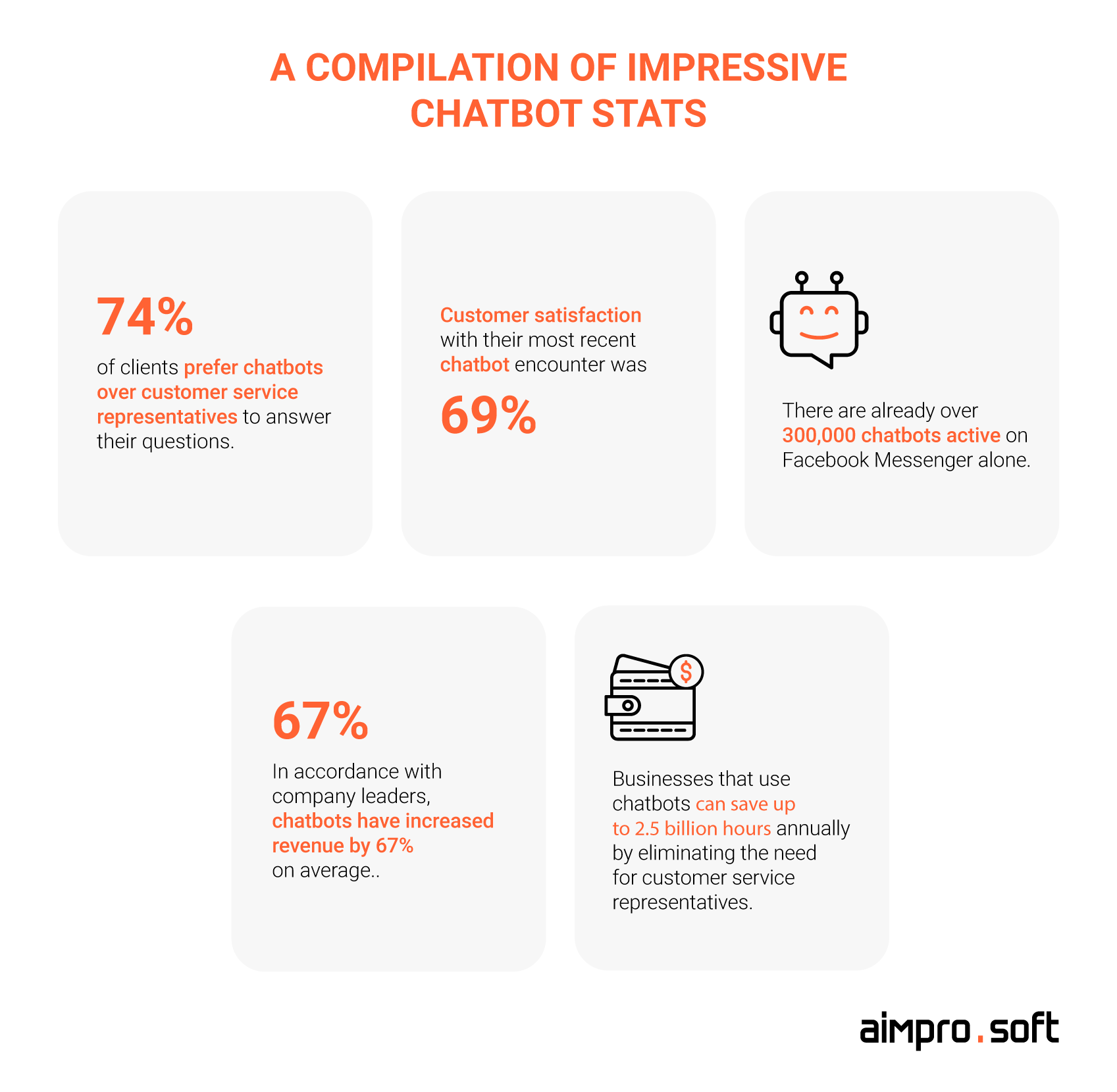
A compilation of the most recent statistics from the chatbot industry. Sources: Demandsage,
VentureBeat, OUTGROW
In this section, we’ll examine the key market trends that are worth following. Their understanding can give you ideas for your product and help you build a sound monetization strategy. Knowing what types of trends are becoming increasingly popular and what modern functionality you can add to empower your product will help you choose the right monetization strategy, ultimately maximizing your chatbot’s profitability.
Creation of voice-powered chatbots
The adoption of voice-powered technology is rapidly increasing, with predictions indicating that over 50% of searches will soon be voice-driven. This trend is particularly popular for businesses in banking, insurance, e-commerce, and healthcare. Voice chatbots are pivotal in delivering seamless interactions with customers. Voice-powered technology increases accessibility, catering to diverse audiences while offering cost savings through task automation, allowing companies and businesses to allocate resources more efficiently.
Making more human-like chatbots
Chatbots are becoming more and more human-like in their social engineering. They are able to understand and respond to natural language, which makes communicating with them more authentic. These improved chatbots, such as ChatGPT, have gained popularity due to their ability to provide realistic and engaging user interactions. They provide round-the-clock support, catering to customers in different time zones and enhancing accessibility. Also, businesses can easily scale their chatbot services to accommodate growing customer demands without proportionally increasing staff.
Usage of AI
These AI-driven chatbot trends are revolutionizing the way businesses operate, especially when transitioning from more legacy systems. According to the survey, 84% of companies believe that AI chatbots will gain importance for customer communication. Without human intervention, AI-powered chatbots can handle routine tasks such as changing passwords, processing requests, and making appointments.
Chatbots are becoming available to companies of all sizes
As we said earlier, people are becoming increasingly accustomed to interacting with chatbots for various purposes, from getting streamlined customer support to assistance with online shopping. This has been fuelled by the improved quality of interactions with chatbots and their ability to provide quick and accurate responses.
In recent years, significant technological advancements have democratized chatbot adoption. Now, even small-scale companies can benefit from the emergence of out-of-the-box chatbot platforms with user-friendly interfaces and templates. Cloud computing eliminates the need for on-premises infrastructure, making chatbots easier to deploy, while open-source chatbot frameworks provide cost-effective customization, and so on. And available artificial intelligence tools, in turn, enable AI integration without high costs.
Enhancing security measures
Protecting privacy and data security is becoming a priority as chatbots are increasingly used in everyday life and business activities. Businesses are constantly trying to improve the security of their interactions with chatbots to alleviate users’ concerns about the safety of their data. Also, questions about bias and fairness in chatbot systems are actively raised to address these issues in the development of modern chatbots.
This shift is primarily driven by the ubiquity of chatbots in everyday life and business. Companies now need to prioritize protecting user data to alleviate growing concerns about its security. For example, implementing end-to-end encryption is one of the most important precautions. It secures user interaction and chatbots, protecting users from unauthorized access.
So, we’ve covered some of the popular trends and benefits that chatbots provide, but implementing chatbots in business takes time and effort. Therefore, to keep up with the competition, you need to have a clear roadmap to grow further and profit from your product. Let’s explore in the next section what type of experts can help you find the right monetization strategy for your product.
Choosing the right expert for chatbot monetization strategy
So, what kind of expert can assist with choosing a chatbot monetization strategy and help make money with bots? From the diversity of professionals, it may seem that it’s quite challenging to find the right one since each of them can contribute to monetizing your bot in different ways. Still, our specialists from Aimprosoft are ready to help you by sharing insights about professionals who specialize in software monetization. Check the list that we compiled and figure out who to hire to unlock the full potential of your chatbot.
Monetization manager
A monetization manager is a specialist responsible for developing and implementing strategies to generate revenue from products or services. Their main task is to find ways to maximize the profitability of the company’s offerings. These are the activities that a monetization manager can perform:
- Revenue Strategy: Monetization managers develop and implement strategies to increase revenue. They analyze market trends, customer behavior, and the competitive landscape to identify monetization opportunities.
- Pricing strategies: They assess the pricing structure for products or services by considering cost, market demand, and competitive pricing. Monetization managers may use pricing models and A/B testing to optimize pricing strategies.
- Data analytics: These professionals work closely with data analysts to extract insights from customer data. This data-driven approach helps make informed decisions regarding pricing, product features, and user engagement.
- Collaboration: Monetization managers collaborate with cross-functional teams, including product managers, C-level executives, designers, and marketers, to align monetization strategy with overall business goals.
Hiring a monetization manager can be helpful for a company in the following cases: to implement complex monetization strategies, such as collaborating with other businesses. Also, when you want to scale your business and increase revenues. It can also be helpful for legal and ethical compliance in competitive markets.
Market research analyst
This specialist plays a critical role in building a software product monetization strategy by providing valuable insights into the market, customers, and competitors. Here’s how their expertise contributes to the process:
- Pricing strategy: Analysts research the market, evaluating pricing models and competitive pricing. They estimate how much customers are willing to pay for similar products, which helps determine the best pricing strategy for the software product.
- Competitive analysis: Market research involves scrutinizing competitors’ products and pricing strategies. Understanding the competitive landscape allows companies to identify their products and pricing’s weaknesses and strengths.
- Target audience: Analysts help identify the target audience of a software product. They create user personas and segments, allowing for more accurate marketing and monetization strategies that target specific consumer groups.
Here’s why you should hire a market research analyst: If you want to enter a market, you need to conduct a competitive analysis of the market before you do so. A market research analyst can help with this. You will benefit from the skills of such specialists for customer research, data-driven decision-making, or optimizing marketing strategies.
Business analyst
Business analysts bridge the gap between a product’s technical aspects and the business’s goals. Here’s how business analysts can help bring your monetization strategy to life:
- Identify revenue streams: The specialist explores different revenue streams that can complement the core monetization model. These could be add-ons, premium features, or licensing options based on customer preferences.
- Risk assessment: This stage assesses the risks associated with different monetization approaches, helping companies make informed decisions to minimize potential negative impacts.
- Data-driven decision-making: Analysts provide recommendations backed by data, ensuring that monetization strategies are based on factual information rather than assumptions.
You should consider hiring a business analyst in the following situations: if you want to streamline business processes, a business analyst can identify bottlenecks and suggest ways to optimize them. As your business grows and becomes more complex, a business analyst can help align your strategy with changing goals and market conditions. Also, you need to ensure that your business strategies are aligned with customer needs and expectations. In that case, a business analyst can help you define those requirements and translate them into actionable plans.
Want to learn more about how business analysts work and ensure product success? Find out more in our article on a related topic.
Product manager
Product managers ensure that the product aligns with the company’s business goals and effectively generates revenue. Here’s how product managers are involved in developing the monetization strategy:
- Defining monetization models: Product managers work with cross-functional teams to determine the most appropriate monetization model for the software product. This considers user value proposition, pricing elasticity, and market demand.
- Feature prioritization: These specialists prioritize developing features that directly impact monetization. This includes identifying premium features, upsell opportunities, and optimizing the user journey for conversions.
- Planning the roadmap: Product managers create a roadmap that outlines the implementation of monetization features over time. They balance revenue-generating elements with product enhancements to maintain user satisfaction.
- Design improvements: Working closely with UX/UI designers, they create a user-friendly and understandable experience for purchasing and accessing premium features. A well-designed UI can have a significant impact on conversion rates.
- KPIs: Managers define key performance indicators (KPIs) to measure the success of the monetization strategy. Metrics such as customer acquisition cost (CAC), customer lifetime value (CLV), and churn rate are closely monitored by them.
You should consider hiring a product manager in the following circumstances. If you plan to enter a new market or launch products for different customer segments, a product manager can assess market dynamics and adapt your product development strategy accordingly. Likewise, a product manager can provide direction and planning when you need to define a clear product vision, roadmap, and strategy to remain competitive and meet customer demands.
Keep in mind that the need for the above-mentioned professionals may vary depending on your company’s unique goals and objectives. So, after examining the types of monetization experts, it’s time to venture into the strategies that can be used to meet your revenue-related goals.
The best chatbot monetization strategies
So, how to make money with bots? Companies often find themselves at a crossroads when choosing chatbot monetization strategies. It’s akin to going on an adventurous journey with a treasure map, but you need to know which path will lead you to the coveted riches. That is why, in this section, we will reveal the most popular and profitable strategies to help you achieve the desired results and make money with bots.
Choosing the right monetization strategy for your business is a crucial decision. However, it’s not just about choosing a popular method but a comprehensive approach based on several key factors.
Factors influencing the choice of monetization strategy:
- Business goals: The monetization strategy should align with the business’s objectives. Defining the purpose is the main factor influencing the choice of monetization strategy.
- Target audience: Analyze and understand your audience’s preferences, product expectations, and willingness to pay.
- Competitors’ products: Analyse how competitors monetize similar products. Identify gaps or opportunities to differentiate your strategy.
- Market trends: Keep an eye on industry trends and changes in consumer behavior. Adapt your strategy to meet changing market demands.
- Scalability: Consider how your monetization strategy can scale as your business grows. Make sure it can cater to a broader user base.
- Selecting the right expert: A product monetization expert can help you with each of these steps above. Pay attention to this step; a specialist will be able to help you with the choice of your strategy faster and more efficiently.
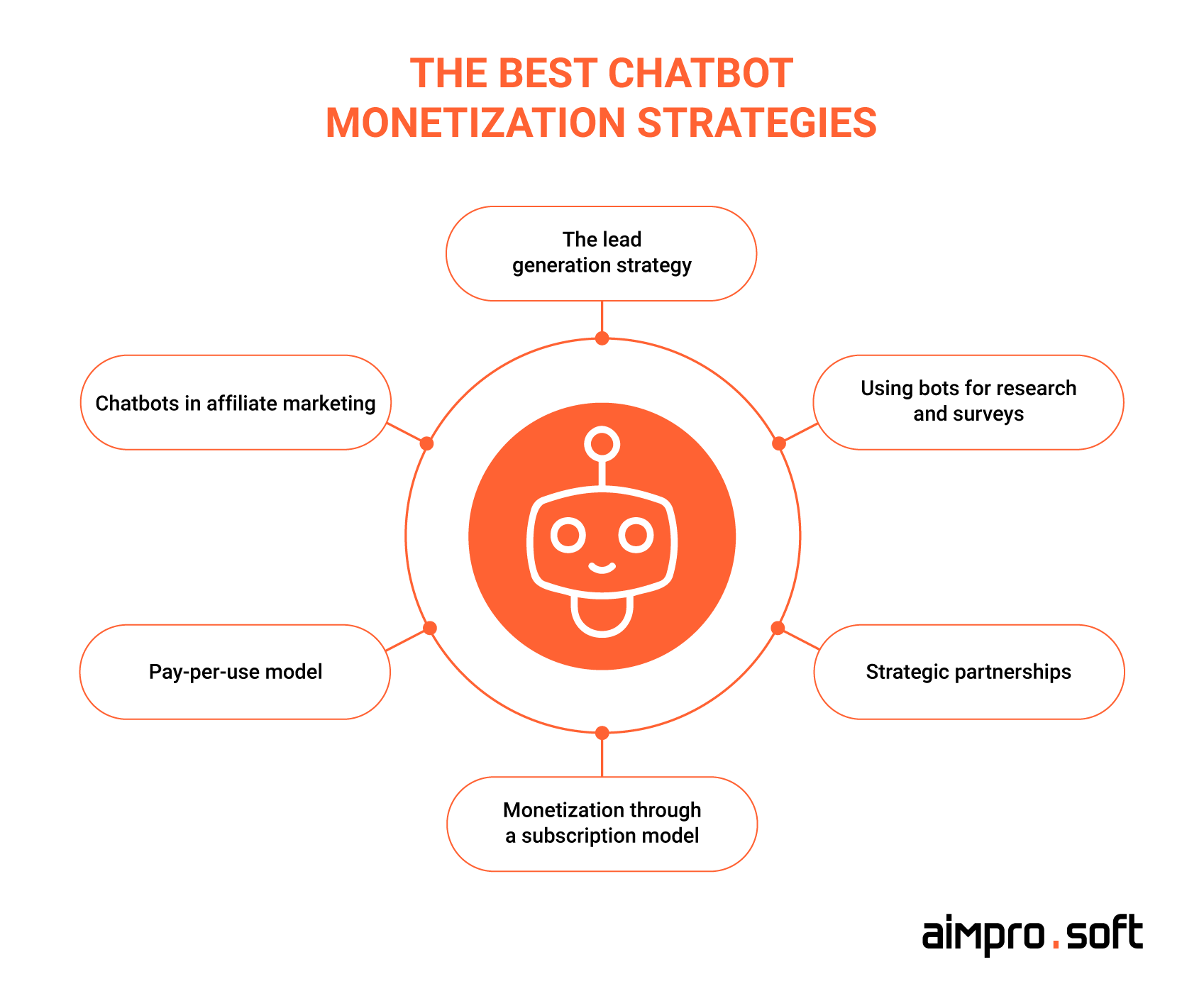
The best chatbot monetization strategies.
The lead generation tactic
Chatbots play a vital role in automating data collection for businesses. They describe services, answer queries, and collect contact details of potential customers. For example, a chatbot embedded into a website can answer common customer questions and prompt them to provide their contact information. This data allows customer service professionals to reach out to users, provide more details about the company’s services or products, and turn potential customers into buyers.
The chatbot can also suggest the visitor to contact a sales manager of the company. The bot will pass all the information to the appropriate employee of the firm, who will then contact them. This technique allows you to both get leads and personalize the interaction.
Advantages
- Customization: You can tailor lead generation efforts to target specific audiences, increasing the chances of conversion.
- Data insights: Gathering leads provides valuable data for understanding customer behavior.
Disadvantages
- Customer expectations: If the chatbot fails to meet customer expectations or provides a poor user experience, it can lead to a negative impression and deter potential customers.
- Regulatory compliance: Handling customer data for lead generation must comply with data protection and privacy regulations. Adherence to these regulations can result in legal issues and damage a company’s reputation.
In which cases is this strategy most suitable?
This strategy is beneficial for businesses that aim to gather valuable customer information and generate potential leads. Chatbots can engage users in conversations, qualify leads, and collect contact details, making them suitable for industries like real estate, education, or B2B services.
Chatbots & affiliate marketing
Chatbots can serve as a valuable tool for generating revenue by providing users with additional information about various products or services. This can be achieved by strategically incorporating advertising or affiliate links into the interaction with the chatbot. The monetization strategy in this context is simple. Chatbot owners work with companies as affiliates and receive commissions for driving sales or traffic. This method relies on proven online business models where chatbots play an active role in facilitating transactions and providing valuable information.
Advantages
- Leverage networks: Affiliates can tap into their existing networks, expanding their reach.
- Performance tracking: You can track the performance of affiliates and campaigns.
Disadvantages
- Quality control: You may have less control over how affiliates promote your product, which can impact your brand’s reputation.
In which cases is this strategy most suitable?
This approach is ideal for e-commerce and content-based platforms where chatbots can promote affiliate products or services through contextual recommendations and earn commissions on sales generated through their referrals.
Native advertising
Native advertising is a model where brands partner with media companies to integrate content into a publisher’s channels seamlessly. Let’s say, as an example, you have a chatbot for a fitness app. While this chatbot may provide users with valuable fitness tips and exercise routines, it can also guide them toward articles like “10 Healthy Recipes for a Balanced Diet.” In this scenario, native advertising bridges the chatbot’s content and sponsored articles related to health and nutrition.
Advantages
- Credibility: Well-executed and useful native content can gain the trust of your audience.
- Variety of formats: You can use different types of content, such as articles, videos, or podcasts for native advertising.
Disadvantages
- Audience relevance: Ensuring native advertising resonates with the platform’s users requires thorough audience research and tailored content. Failing to do so can make the content appear out of place and disengage users.
In which cases is this strategy most suitable?
Native advertising through chatbots is useful for media and content websites. Chatbots can seamlessly integrate sponsored content or product placements into their conversations, offering a non-disruptive way to get revenue.
Using bots for research and surveys
Chatbots are valuable tools for market research and collecting feedback. They employ natural language processing to understand user queries, including casual language, simplifying communication. Additionally, chatbots’ conversational nature adds an element of engagement to surveys, increasing the likelihood of survey completion. Such chatbot capabilities can be utilized to introduce a subscription model, where users pay for access to exclusive surveys and analytical materials. Also, the data obtained can be used by companies to target users with relevant advertising, which can become another source of revenue.
Advantages
- Data collection: Surveys and research can provide valuable insights into customer needs.
- Engagement: Involving customers in the development process can increase engagement and loyalty.
Disadvantages
- Accuracy: Ensuring unbiased and representative data can be challenging.
In which cases is this strategy most suitable?
Industries requiring market research, consumer insights, or feedback, such as consumer goods or market research firms, can use chatbots to conduct surveys and gather data, which can be sold to interested parties.
Strategic partnerships
If you have developed a chatbot product but need more time to monetize it, consider partnering with companies or organizations that can leverage the chatbot’s marketing strategy to generate revenue. Look for partners who see value in your chatbot and have the resources to monetize it effectively. In today’s competitive environment, monetizing chatbots is possible and necessary. To do so, you have to be creative rather than reinvent the wheel. A strategic partnership will help unlock chatbots’ full potential and achieve mutual success.
Advantages
- Leveraged expertise: Partnering with established companies can provide access to their expertise and customer base.
- Synergy: Collaboration can lead to innovative solutions and new product features.
Disadvantages
- Dependency: Overreliance on a partner can be risky if the partnership deteriorates.
In which cases is this strategy most suitable?
This approach is versatile and suits businesses across various sectors. Chatbots can form partnerships with complementary services or products and share revenues generated from cross-promotion or referrals. It’s an effective strategy for businesses seeking collaborative monetization.
Monetization through a subscription model
ChatGPT allows users to learn new skills and obtain certifications conversationally and interactively. So, how to use chatgpt to make money? ChatGPT can be a virtual tutor, providing users with a personalized learning experience. Users can engage in a dialogue with the chatbot and learn topics ranging from language proficiency to technical skills. Monetization can be done through a subscription model. Users can access essential learning content for free and subscribe to premium content, personalized lessons, and certification programs.
Advantages
- Personalization: Chatbots can adapt to individual learning styles, offering a tailored learning experience.
- Scalability: The chatbot can accommodate a large user base without additional infrastructure costs.
Disadvantages
- Quality and accuracy: Users may encounter inaccuracies, misinformation, or biased content, which can negatively impact learning outcomes.
- Privacy concerns: Sharing personal and learning data through ChatGPT raises privacy concerns, especially when sensitive information is involved
In which cases is this strategy most suitable?
Content creators, news publishers, and educational platforms can opt for a subscription-based model. Chatgpt make money by offering premium content, personalized services, or exclusive access that can generate consistent revenue from subscribers.
Pay-per-use and consulting bots
Another way to make money with ai bots is a pay-per-use monetization model where a product or service is charged to the consumer based on usage. This model works best for consultant bots that provide expert advice. A pay-per-use model allows you to charge users for each interaction with the bot, aligning costs with the value provided.
Advantages
- Сlear value proposition: This strategy provides a clear value proposition and encourages users to try the service without minimum commitment. It also allows for detailed usage data to help users make purchasing decisions.
Disadvantages
- Limited reduction in the total cost of ownership (TCO): The total cost of ownership may not see a significant decrease compared to other pricing models, which can be a drawback for cost-conscious users.
In which cases is this strategy most suitable?
Businesses offering specialized expertise, advice, or consultations, such as legal or financial services, can charge users on a pay-per-use basis. This strategy ensures revenue generation each time the bot provides its services, making it suitable for service-oriented industries.
Learn more about how GPT-4 can be beneficial to your business. Read our complete guide on the topic.
After choosing a monetization strategy, it’s crucial to consider the metrics that will help you evaluate its success and make informed decisions for optimizing your approach.
To measure the success of your chosen monetization strategy, consider the following key metrics:
Customer Acquisition Cost (CAC): Calculate the cost of acquiring each customer, helping you evaluate the efficiency of your strategy.
Customer Lifetime Value (CLV): Determine the long-term value of a customer to understand if your strategy is generating sustainable revenue.
Conversion Rate: Monitor the percentage of users who take the desired action (e.g., making a purchase), indicating the effectiveness of your strategy.
Churn Rate: Keep an eye on how many customers you lose over time to identify potential issues with your monetization model.
Average Revenue Per User (ARPU): Calculate the revenue generated per user to assess the profitability of your strategy.
Remember that a successful monetization strategy is not static but requires ongoing evaluation and adaptation to remain competitive and profitable in a dynamic market.
To choose the perfect strategy, you need competent experts, a deep understanding of your target audience, a thorough analysis of your competitors, and a crystal clear vision of your business goals. It’s not just about choosing a method but developing a comprehensive approach that considers the specifics of your business. So, when diving into chatbot monetization, remember that success is achieved through a fusion of experience, strategy, and a deep understanding of the market. Now, let’s look at examples of how well-known companies have already implemented some of the monetization strategies we listed above and are making a profit.
Successful examples of businesses making money with chatbots
We have discussed many examples of how to monetize a chatbot, what strategies you should choose, and what experts can help you. These tips will help you to come to successful money generation with chatbots. But now let’s examine some successful examples of big companies using chatbot to make money to inspire you to create a profitable product. These companies have already implemented chatbots into their products, either by collaborating with other chatbot developers or by creating their own. They make money with bots, attract more customers to their company, and increase their profits.
Subway
Subway is an international restaurant chain specializing in sandwiches and salads. Subway restaurants can be found in many countries, and their menus and promotions may vary depending on location.
Subway has launched a conversational artificial intelligence system deployed as the Google RCS bot. Google RCS is a modern messaging platform designed to replace traditional SMS. The Subway RCS chatbot is designed for business messaging and uses the RCS capabilities to send engaging multimedia messages to users’ smartphones. Subway’s first marketing campaign is using bots to make money.
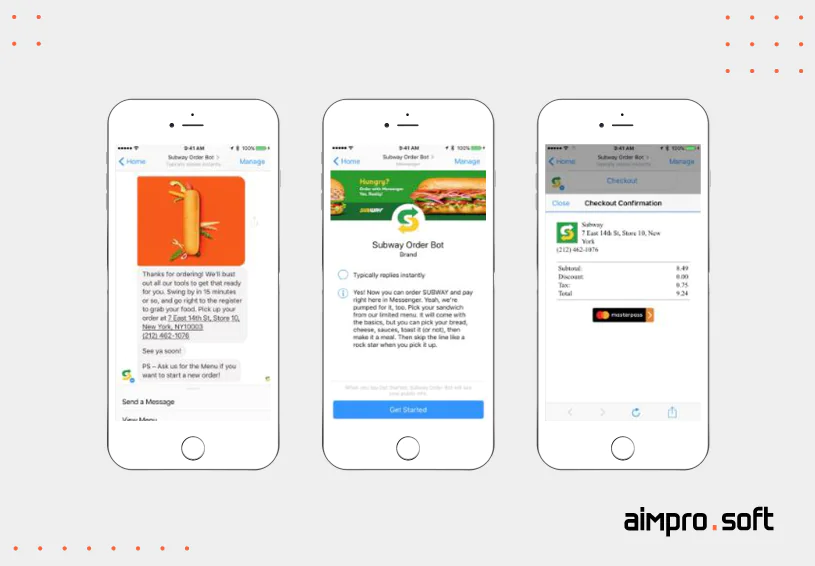
Subway bot interface.
H&M
H&M is a global fashion retailer, a mass-market brand known worldwide. H&M has developed an artificial intelligence chatbot powered by Kik to meet ever-changing consumer demands. H&M use chatbot to make money to engage users by asking them questions to understand their fashion preferences better. To improve efficiency, this artificial intelligence chatbot for conversational commerce also shares images of clothing items to help users answer style questions. In addition, given the active participation of online shoppers in social polls and discussions, H&M’s chatbot offers the opportunity to explore existing outfits and vote on them.
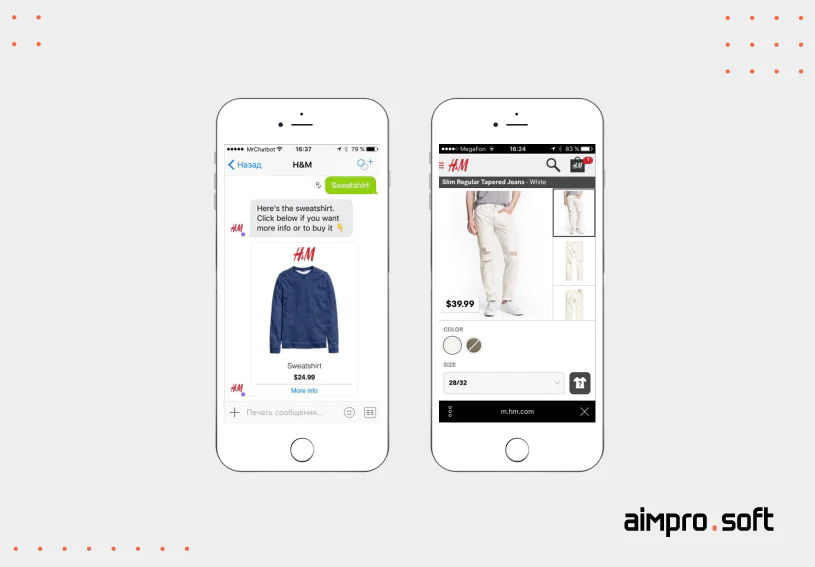
H&M bot interface.
IBM
IBM is a multinational technology company known for its information technology and computing innovations. One of IBM’s notable contributions to the world of AI and chatbots is IBM Watsonx. IBM Watsonx Assistant is a unique offering focused on building chatbots and virtual assistants in the IBM Watson ecosystem. It allows companies to develop AI-based conversational agents that can mimic human interaction. These chatbots can be deployed across various channels, including websites, messaging apps, and voice assistants.
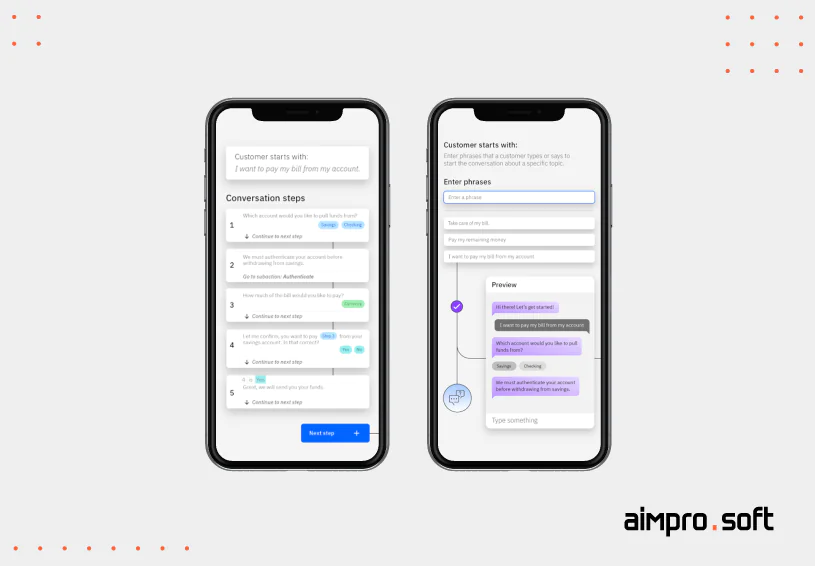
IBM bot interface.
Delta
Delta Air Lines is a major American headquartered airline, one of the world’s largest and well-known airlines. Delta has a rich history and an extensive global flight network serving domestic and international destinations. Delta Air Lines has implemented Apple Business Chat-based support for customer service, leveraging artificial intelligence to meet customer expectations and provide efficient assistance.
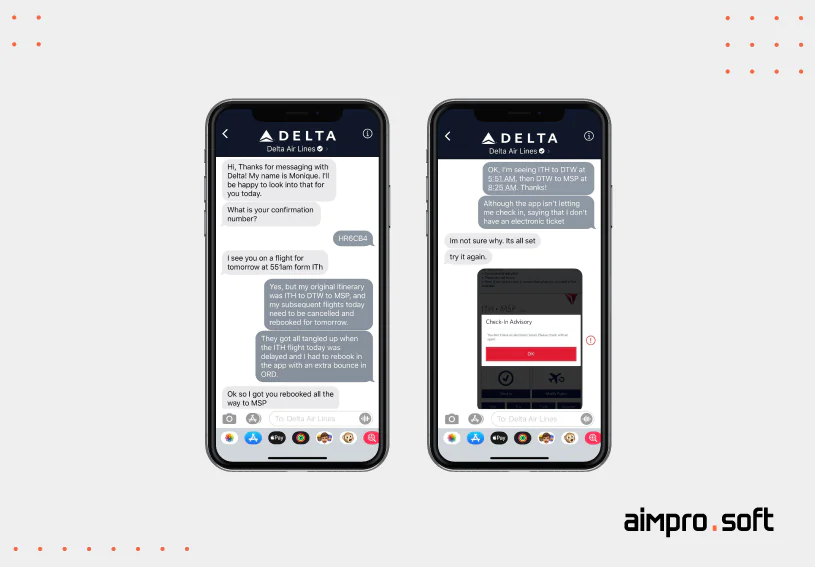
Delta bot interface.
Starbucks
Starbucks is a world-renowned coffee chain and one of the most recognizable brands in the world. Starbucks has a significant global presence: thousands of shops in more than 80 countries. Starbucks uses bots to make money and has implemented an effective marketing strategy through its chatbots, which has proven highly successful. This innovative chatbot delivers a personalized and hassle-free customer experience, boosting customer engagement, heightened loyalty, and increased sales.
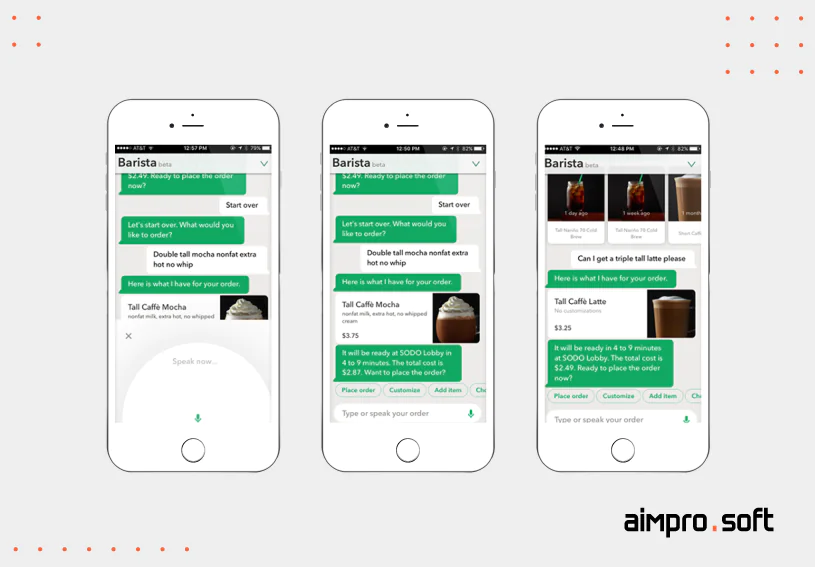
Starbucks bot interface.
We have looked at how to use bots to make money with real examples. One idea can conclude that it’s not just about choosing a monetization strategy but also about a comprehensive approach, combining the use of innovation, proper targeting, and analyzing competitors in the market. Now, let’s see how Aimprosoft can help you achieve your desired monetization results.
How can Aimprosoft assist businesses to earn money using chatbots?
With over 18 years of experience in the IT industry, Aimprosoft has built a reputation as a reliable partner for your business. We are always ready to make concessions to our customers and fulfill all your requirements. Our experts will provide everything you require to create a successful commercial chatbot. Here’s a list of activities we can complete to help you build a chatbot to implement your monetization strategy:
- Our business analyst team can help you increase your revenue
A business analysis specialist can get involved in a project at the earliest stages, from the moment an idea is conceived, and provide essential assistance in preparing documentation, analyzing the market, and ensuring that the chatbot meets the market’s needs. Even if you already have an existing product that needs to deliver the desired results, a BA specialist can help identify gaps and optimize the product to increase its monetization.
- Modern functionality
Our team of experienced developers will create fully compliant functionality with modern market requirements.
- Attractive design
Our UI/UX designers will add appeal and usability to your product with an intuitive visual interface.
- Commercial success
We have a proven track record of creating commercially orientated chatbots, and our completed projects continue to generate revenue for our clients.
One of our examples of commercial chatbot development
Customer request. The client’s initial task was to create a chatbot for their perfume shop. Their idea was to offer personalized perfume recommendations to website visitors using a chatbot that could collect customer data and use it to suggest the right products for them.
Implementation of the idea. To fulfill the initial need of the client to create a chatbot, we developed a highly effective chatbot that helped visitors choose perfumes and other perfumery products. Based on the data, the chatbot offered several perfume options that could interest the visitor. In addition, we integrated purchase links directly from the chatbot, making the purchase process quick and convenient.
Monetization. For this project, a monetization strategy based on partnership was chosen, meaning providing the chatbot to other companies operating in the perfume industry. In this way, the client could increase sales in their shop and offer a valuable solution to other companies, expanding their audience and increasing revenue.
Outcome. The right choice of advanced technologies like Node.js, PostgreSQL, JavaScript, and the proper approach to monetization allowed us to create a product that enabled the client to attract more customers and increase sales.
Contact us, and our experts will help you realize your goal.
CONTACT USConclusion
By hiring a skilled specialist and carefully assessing different chatbot monetization strategies, you can create a chatbot that generates revenue and provides significant value to your audience. The options are abundant, from data sales and custom surveys to targeted advertising and strategic partnerships. However, choosing a monetization strategy is more than just a decision; it’s a holistic approach. It involves engaging with experts, understanding your audience, and leveraging data analytics. By considering these factors, you can maximize your chatbot’s revenue potential.
So why wait? Dive into the world of this exciting technology and start your journey to chatbot-driven profitability today by building on the ideas we’ve explored in our article. If you still have unclosed questions, you can always contact us, and together, we can find the best solution for your chatbot monetization idea.
FAQ
Can chatbots really help businesses make money?
Yes, chatbots can be a powerful tool for generating revenue. Chatbots can suggest related products or services, increasing the average transaction value. They can also optimize customer interaction, improve response times, and enhance the user experience, leading to higher sales and lower operating costs.
Are there specific industries or businesses that can benefit the most from using chatbots for revenue generation?
Various industries can benefit, but e-commerce, customer support, banking, and the hospitality sector have seen significant advantages by integrating chatbots into their businesses. E-commerce uses chatbots for sales and customer assistance. Chatbots handle routine inquiries in customer support, and the hospitality industry employs them for bookings and recommendations. In the banking industry, chatbots play a pivotal role in providing customers with efficient and personalized financial services.
What are some common ways businesses monetize chatbots?
Common monetization strategies include data sales, offering custom surveys, implementing subscription models for premium content, and engaging in targeted advertising. Partnerships with other businesses can also be a profitable approach.
How can I create a chatbot that generates income for my business?
Creating a profitable chatbot involves, first of all, defining clear goals for your product, which usually occurs at the discovery stage, as well as choosing the right type of monetization (e.g., for lead generation or customer service). Next, selecting the right platform for deployment and integrating the chatbot with business systems. Also, it would help if you did not skip the critical stage of analyzing user data to improve the chatbot based on feedback constantly.
Are there any legal or ethical considerations when using chatbots for profit?
Yes, it is essential to consider privacy and data protection requirements, and here are some tips on how you can do that. Chatbots often handle sensitive user data. Protecting sensitive user data from adversarial attacks when using a chatbot involves employing robust encryption, stringent access controls, regular security audits, and safeguards to ensure the highest level of data security. Make sure your chatbot is compliant with data protection regulations like GDPR.
Users should be informed about data collection and be able to give consent. It’s essential to let users know they are interacting with a chatbot, not a human. Transparency builds trust and helps manage user expectations. Chatbots can inadvertently inherit biases from the data they are trained on. Therefore, regularly monitor and adjust chatbot responses to avoid discriminatory or biased behavior.




